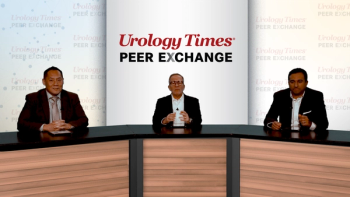
RX Review: TURBT vs chemoablation for low-grade, intermediate-risk NMIBC
In this video, part 4 in a 5-part series, Nick Liu, MD, outlines key scenarios where surgical resection remains preferred for treating LG-IR-NMIBC.
Episodes in this series

In this Special Report: RX Review from Urology Times, host Rahul Mehan, MD, and Nick Liu, MD, explore the nuanced decision-making around chemoablation vs surgery in the treatment of low-grade, intermediate-risk non–muscle invasive bladder cancer (LG-IR-NMIBC), as they assess where mitomycin for intravesical solution (Zusduri; formerly UGN-102) fits—and where transurethral resection of bladder tumor (TURBT) still holds value. The treatment was approved by the FDA on June 12, 2025.1,2
In this clip, Liu emphasizes that TURBT isn’t going away. He outlines key scenarios where surgical resection remains preferred: when there’s diagnostic uncertainty, concern for high-grade features or carcinoma in situ, limited patient access to weekly instillations, or patient preference for definitive resection. For some, TURBT remains a “one-and-done” option, particularly in rural areas or among patients who are anxious about leaving cancer in place during chemoablation.
Both physicians agree that mitomycin for intravesical solution expands the treatment toolbox without replacing surgery altogether. They highlight the real-world burden of bladder cancer—it’s the sixth most common malignancy in the US, with a recurrence rate of up to 70% in this risk group. Introducing durable, non-surgical options may be a game-changer for patients and providers alike, especially in an aging population.
They also address tolerability: adverse events like dysuria, hematuria, and urinary tract infections were expected in clinical trials. In the phase 3 ENVISION study (NCT05243550), dysuria occurred in about 23% of patients, and in the phase 3 ATLAS trial (NCT04688931), the rate was closer to 30%. Importantly, two-thirds of patients were of Medicare age and over one-third were age 75 or older—yet most tolerated treatment well, with grade 3 events occurring in fewer than 4% of patients.
For Mehan and Liu, the takeaway is clear: Mitomycin for intravesical solution may not be the right fit for everyone, but it represents a powerful new option—especially in a disease space long dominated by recurrence and surgical fatigue.
More From This Series:
Our Panelists:
Rahul Mehan, MD, is the founder of East Valley Urology Center in Mesa, Arizona.
Nick Liu, MD, is the medical director of urology at Valley Health System in Paramus, New Jersey.
Mehan and Liu report no relevant disclosures.
REFERENCES
1. FDA approves mitomycin intravesical solution for recurrent low-grade intermediate-risk non-muscle invasive bladder cancer. News release. US Food & Drug Administration. Published online and accessed June 12, 2025. https://www.fda.gov/drugs/resources-information-approved-drugs/fda-approves-mitomycin-intravesical-solution-recurrent-low-grade-intermediate-risk-non-muscle
2. U.S. FDA approves UroGen’s ZUSDURI (mitomycin) for intravesical solution as the first and only medication for recurrent low-grade intermediate-risk non-muscle invasive bladder cancer (LG-IR-NMIBC). News release. UroGen. Published online and accessed June 12, 2025. https://investors.urogen.com/news-releases/news-release-details/us-fda-approves-urogens-zusduritm-mitomycin-intravesical
Newsletter
Stay current with the latest urology news and practice-changing insights — sign up now for the essential updates every urologist needs.



















